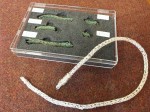 Archaeologists excavating Rufford Abbey, a country estate in Nottinghamshire, England, that was once a Cistercian monastery, have discovered the remains of a vicious-looking copper scourge. Nottinghamshire County Council community archaeologists were digging under a meadow on the property in 2014 when they saw a green stain in the soil. The stain surrounded pieces of wire copper strands that had been braided together in tubular form.
Archaeologists excavating Rufford Abbey, a country estate in Nottinghamshire, England, that was once a Cistercian monastery, have discovered the remains of a vicious-looking copper scourge. Nottinghamshire County Council community archaeologists were digging under a meadow on the property in 2014 when they saw a green stain in the soil. The stain surrounded pieces of wire copper strands that had been braided together in tubular form.
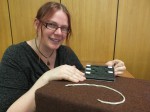 They weren’t certain what the fragments were, but archaeologists Emily Gillott and Lorraine Horsley thought it was reminiscent of a copper scourge unearthed in the dormitory area of the ruins of Rievaulx Abbey in Yorkshire. Testing of the artifact and consultation with experts has now confirmed that Gillot and Horsley were correct. It is one of only four monastic copper scourges known in Britain. The other three are at Rievaulx, Roche Abbey and Grovebury Priory. The exact date of manufacture and use is unknown, but it’s from the late medieval period.
They weren’t certain what the fragments were, but archaeologists Emily Gillott and Lorraine Horsley thought it was reminiscent of a copper scourge unearthed in the dormitory area of the ruins of Rievaulx Abbey in Yorkshire. Testing of the artifact and consultation with experts has now confirmed that Gillot and Horsley were correct. It is one of only four monastic copper scourges known in Britain. The other three are at Rievaulx, Roche Abbey and Grovebury Priory. The exact date of manufacture and use is unknown, but it’s from the late medieval period.
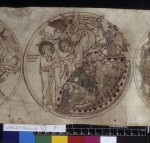 These were personal items, likely used in the privacy of a monk’s own cell. He would beat himself with the scourge in voluntary penance, to mortify his flesh for his sins and the sins of everyone he prayed for as Christ voluntarily sacrificed his body for the sins of mankind. There was a long and controversial tradition of self-flagellation in the Catholic Church, particularly in monastic life. St. Peter Damien introduced the practice as part of a new, stricter interpretation of the Rule of St. Benedict at the Camaldolese priory of Fonte Avellana in the 11th century. His self-flagellation rule was that it should be performed accompanied by the recital of psalms, 100 strokes of a leather thong on the bare back per psalm. The entire psalter would take 15,000 strokes to get through. Peter Damien suggested 40 Psalms and 4,000 stripes at a time should suffice, under normal circumstances, but the practice caught on like wildfire in the monastery and many monks outdid each other to pass that mark.
These were personal items, likely used in the privacy of a monk’s own cell. He would beat himself with the scourge in voluntary penance, to mortify his flesh for his sins and the sins of everyone he prayed for as Christ voluntarily sacrificed his body for the sins of mankind. There was a long and controversial tradition of self-flagellation in the Catholic Church, particularly in monastic life. St. Peter Damien introduced the practice as part of a new, stricter interpretation of the Rule of St. Benedict at the Camaldolese priory of Fonte Avellana in the 11th century. His self-flagellation rule was that it should be performed accompanied by the recital of psalms, 100 strokes of a leather thong on the bare back per psalm. The entire psalter would take 15,000 strokes to get through. Peter Damien suggested 40 Psalms and 4,000 stripes at a time should suffice, under normal circumstances, but the practice caught on like wildfire in the monastery and many monks outdid each other to pass that mark.
One of the monks at Fonte Avellana under St. Peter Damien’s leadership was St. Dominic Loricatus, whose moniker was a reference to the chain mail he wore next to his skin to torture himself harder than by wearing a mere hairshirt. He committment to self-flagellation was so extreme it seems impossible to be true. It got him a mention in Edward Gibbon The History of the Decline and Fall of the Roman Empire.
It is a maxim of the civil law, that whosoever cannot pay with his purse, must pay with his body; and the practice of flagellation was adopted by the monks, a cheap, though painful equivalent. By a fantastic arithmetic, a year of penance was taxed at three thousand lashes; and such was the skill and patience of a famous hermit, St. Dominic of the iron Cuirass, that in six days he could discharge an entire century, by a whipping of three hundred thousand stripes.
That’s 50,000 stripes a day. St. Peter Damien offered different figures in the biography he wrote of St. Dominic Loricatus. He said Loricatus did 12 Psalters without a break until he died of exhaustion in 1063. One Psalter = 15,000 lashes, so 12 = 180,000. Either way it’s horrifying, and that was with leather whip, not a copper one.
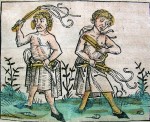 Self-flagellation became a regular part of monastic disciple for other rules as well, and spread far and wide during times of crisis, most notably when the Black Death tore through Europe in 1349. Flagellants would travel from city to city, naked from the waist up, whipping themselves while reciting psalms. They hoped their brutal public voluntary penance in imitation of Christ would persuade God to have mercy on the towns they visited and spare them from any further horrors of the plague. They probably helped spread it instead.
Self-flagellation became a regular part of monastic disciple for other rules as well, and spread far and wide during times of crisis, most notably when the Black Death tore through Europe in 1349. Flagellants would travel from city to city, naked from the waist up, whipping themselves while reciting psalms. They hoped their brutal public voluntary penance in imitation of Christ would persuade God to have mercy on the towns they visited and spare them from any further horrors of the plague. They probably helped spread it instead.
It’s possible that the copper scourges found in the English monasteries were used during the plague years as well. They’re certainly mean enough to suggest they were a response to a situation requiring extraordinary countermeasures.
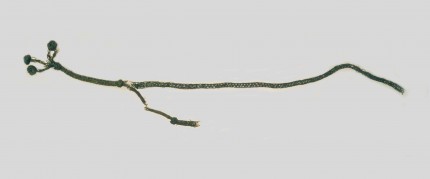
It is worth noting–weirdly enough–that a braided copper scourge would presumably have been a “luxury item” that few could afford.
She is showing off that copper whip with a bit of wicked smile. 👿
She’s showing off that whip with a wicked smile.
Sweet Memories.. A couple of years ago in Southern Germany, on a great sunny afternoon around 6 pm during the week, me unsuspectedly enjoying the afternoon sun with a cone of ice-cream in hand, I witnessed a Catholic procession that all of a sudden had appeared on the scene.
The whole thing was maybe 150 to 200m in length. In front some officials carrying symbols followed by the priest, preaching to the sick and the lame over a microphone. Then, under some form of movable canopy, something of apparently even greater importance and a massive speaker wirelessly connected to the priest’s microphone.
After a short while, the priest had vanished behind the next corner and the loudspeaker only gave strange noises, a group of lay people was following and, with a distance of maybe another 20m behind them, the Elderly, the Sick and the Lame – Truly, spectacular !
—
P.S.: Later, I made up there also were Flagellants, which to my surprise hardly did impress anyone. I am pretty sure, however, had I come just a few centuries earlier, they definitely would have had some 😉
I make driving whips for a living and often get requests (which I turn down) for other types of whips. Once, out of idle curiosity I did some research and discovered that a convent in France made whips for flagellation cheaper than I could buy the materials and sent each one out with a prayer.
In 1493, those ‘Nuremberg Chronicles’ noted right next to that illustration that …
“The Sect or Misbelief of the Flagellants has had its roots in the ‘Walhaz’ countries and has found its way from there to France and Germany. Those Flagellants caned themselves with Scourges that were knotted and barbed-within. This resulted in much confusion in the Faith and Sacraments that to a certain extent lately got eradicated with fire and sword.”
Originally, its German version, in addition to the international Latin one, reads
“Die seckt oder irrglawb der gaislenden hat in welschem land vrsprung gehabt vnnd von dannen in teuetsche land vnd in galliam gekrochen. Dieselben gaiselten sich mit geknoepften vnd mit stacheln darein verfasten gaiseln. Darauß entstuond vil irrung beym glawben vn den sacramenten die zu letst zum tail mit fewr vnnd schwert außgerewtet wardt.“
Looks like a bit of old lightning rod cable!
I think that somehow the teachings of Jesus got off track in the minds of some of his followers.
This sounds like a Eucharistic procession, normally four men carry a canopy over a priest who carries the Eucharist in a monstrance (aka ostensorium). Basically it is a procession honoring and adoring Christ the King (really present in the Eucharist), and meant to bless the parish territory/town. Such processions can be seen all over the world wherever there are devout Catholics, with pageantry and music that varies locally. My parish does this every year for the Feast of Corpus Christi after Easter, that is the most typical time but there can be other occasions for such processions. Sometimes onlookers who understand what this is will make the sign of the Cross or kneel as Christ passes by. Eucharistic processions are a kind of celebration and would never include flagellation for sure though!